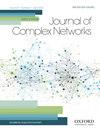考虑局部和全局特征,动态识别复杂网络中的重要节点
IF 2.2
4区 数学
Q2 MATHEMATICS, INTERDISCIPLINARY APPLICATIONS
引用次数: 0
摘要
通过将中心性度量与社群检测相结合,可以更好地洞察复杂网络中重要节点演变的本质。同时,考虑局部和全局特征可以增强复杂网络中重要节点的动态识别能力。局部特征侧重于节点在其邻域内的直接连接和互动,而全局特征则考虑整个网络的整体结构和动态。在动态网络中,本地中心度高的节点可能会在本地信息传播或影响中发挥关键作用。在全局层面上,社群检测算法对整体网络结构和重要节点之间的连接性有重大影响。因此,综合考虑局部和全局特征,可以更全面地了解节点如何动态地促进复杂网络的运行。为了更全面地分析复杂网络,本文通过考虑局部和全局特征(INLGC)来识别重要节点。对于局部特征,INLGC 开发了一种基于网络约束系数的中心性度量,可以更好地理解相邻节点之间的关系。对于全局特征,INLGC 开发了一种群体检测方法,以提高重要节点排名的分辨率。在多个真实世界数据集上进行了广泛的实验,并基于易感-感染-恢复模型评估了各种性能指标。仿真结果表明,INLGC 在精度和分辨率方面更具竞争优势。本文章由计算机程序翻译,如有差异,请以英文原文为准。
Dynamic identification of important nodes in complex networks by considering local and global characteristics
By combining centrality measures and community detection, a better insight into the nature of the evolution of important nodes in complex networks is obtained. Meanwhile, the dynamic identification of important nodes in complex networks can be enhanced by considering both local and global characteristics. Local characteristics focus on the immediate connections and interactions of a node within its neighbourhood, while global characteristics take into account the overall structure and dynamics of the entire network. Nodes with high local centrality in dynamic networks may play crucial roles in local information spreading or influence. On the global level, community detection algorithms have a significant impact on the overall network structure and connectivity between important nodes. Hence, integrating both local and global characteristics offers a more comprehensive understanding of how nodes dynamically contribute to the functioning of complex networks. For more comprehensive analysis of complex networks, this article identifies important nodes by considering local and global characteristics (INLGC). For local characteristic, INLGC develops a centrality measure based on network constraint coefficient, which can provide a better understanding of the relationship between neighbouring nodes. For global characteristic, INLGC develops a community detection method to improve the resolution of ranking important nodes. Extensive experiments have been conducted on several real-world datasets and various performance metrics have been evaluated based on the susceptible–infected–recovered model. The simulation results show that INLGC provides more competitive advantages in precision and resolution.
求助全文
通过发布文献求助,成功后即可免费获取论文全文。
去求助
来源期刊

Journal of complex networks
MATHEMATICS, INTERDISCIPLINARY APPLICATIONS-
CiteScore
4.20
自引率
9.50%
发文量
40
期刊介绍:
Journal of Complex Networks publishes original articles and reviews with a significant contribution to the analysis and understanding of complex networks and its applications in diverse fields. Complex networks are loosely defined as networks with nontrivial topology and dynamics, which appear as the skeletons of complex systems in the real-world. The journal covers everything from the basic mathematical, physical and computational principles needed for studying complex networks to their applications leading to predictive models in molecular, biological, ecological, informational, engineering, social, technological and other systems. It includes, but is not limited to, the following topics: - Mathematical and numerical analysis of networks - Network theory and computer sciences - Structural analysis of networks - Dynamics on networks - Physical models on networks - Networks and epidemiology - Social, socio-economic and political networks - Ecological networks - Technological and infrastructural networks - Brain and tissue networks - Biological and molecular networks - Spatial networks - Techno-social networks i.e. online social networks, social networking sites, social media - Other applications of networks - Evolving networks - Multilayer networks - Game theory on networks - Biomedicine related networks - Animal social networks - Climate networks - Cognitive, language and informational network
 求助内容:
求助内容: 应助结果提醒方式:
应助结果提醒方式:


